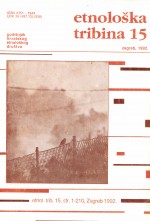Pučko sakralno graditeljstvo Slavonije
Folk Church Architecture of Slavonia
Author(s): Žarko ŠpaničekContributor(s): Stjepan Grgić (Translator)
Subject(s): Customs / Folklore, Architecture, History of Church(es), Modern Age
Published by: Hrvatsko etnološko društvo
Keywords: folk Church architecture; monasteries; Slavonia; modern ages; building techniques;
Summary/Abstract: According to historical data, the medieval Slavonia was a developed and well inhabited Croatian district with numerous churches and monasteries. In the course of the 16th and 17th c., during the Turkish reign, a lot of churches were destroyed and sporadically replaced with wooden chapels. Folk church architecture started flourishing after Slavonia had been liberated from the Turks in the 18th c. Building techniques as well as materials varied, but wood was the dominant one. The majority of buildings were little, very often without a bell-tower, ceiling and other elements. Sometimes only bell-towers were erected (just a bell attached to wooden poles). As the social circumstances gradually improved, brick and stone churches were erected in place of the wooden ones at the end of die 18th and in the 19th c. This indicates that wooden church architecture was only a temporary and transitional phase in church building, conditioned by the.circumstances. Until today two log-cabin-like churches have remained in the western part of Slavonia. The author ends the paper by drawing a comparison between the devastation of Slavonia during the Turkish period and the contemporary one. Once the most recent war is finished, Croatia will be faced with a need to rebuild many of its destroyed churches. The author suggests that a revival of wooden church architecture might temporarily satisfy the need for a quick renewal, hoping that modem technological, social and other conditions may impose new solutions which would not be the mere repetition of the old ones.
Journal: Etnološka tribina : Godišnjak Hrvatskog etnološkog društva
- Issue Year: 22/1992
- Issue No: 15
- Page Range: 157-173
- Page Count: 17
- Language: Croatian

